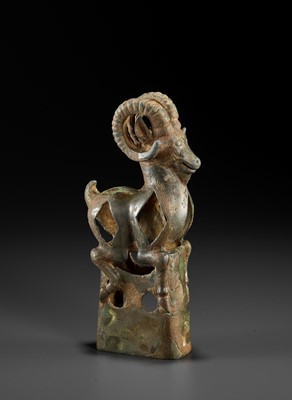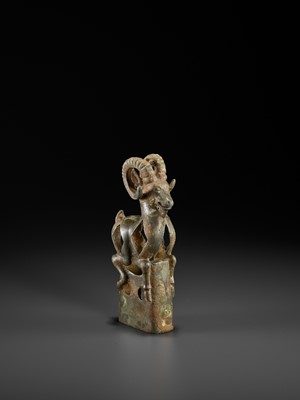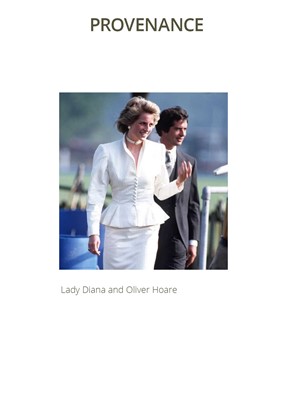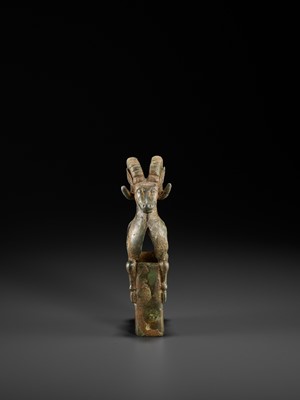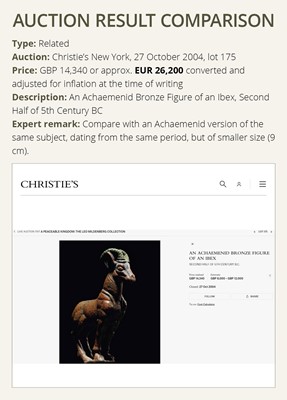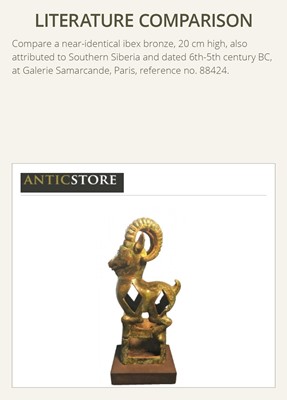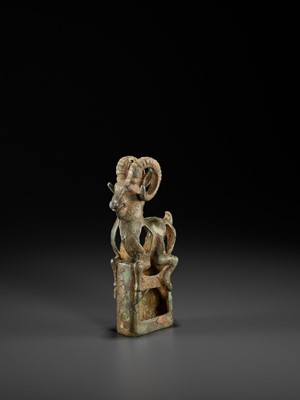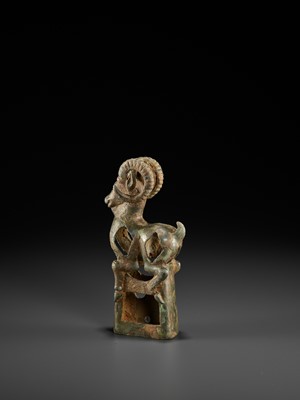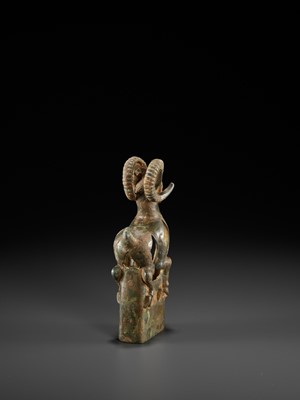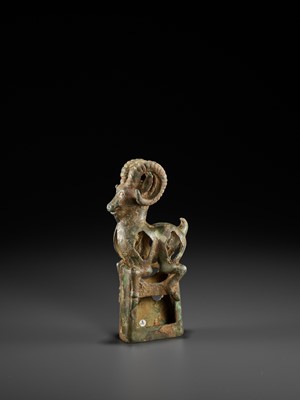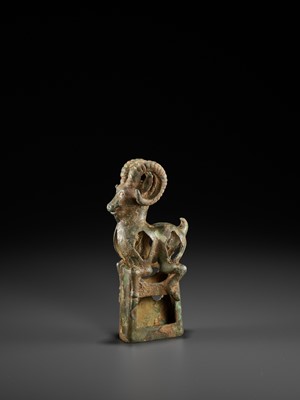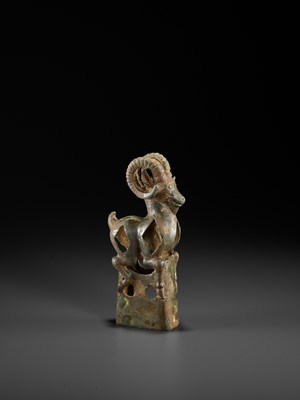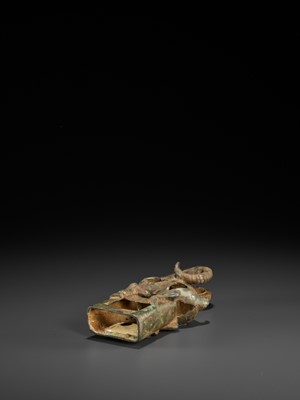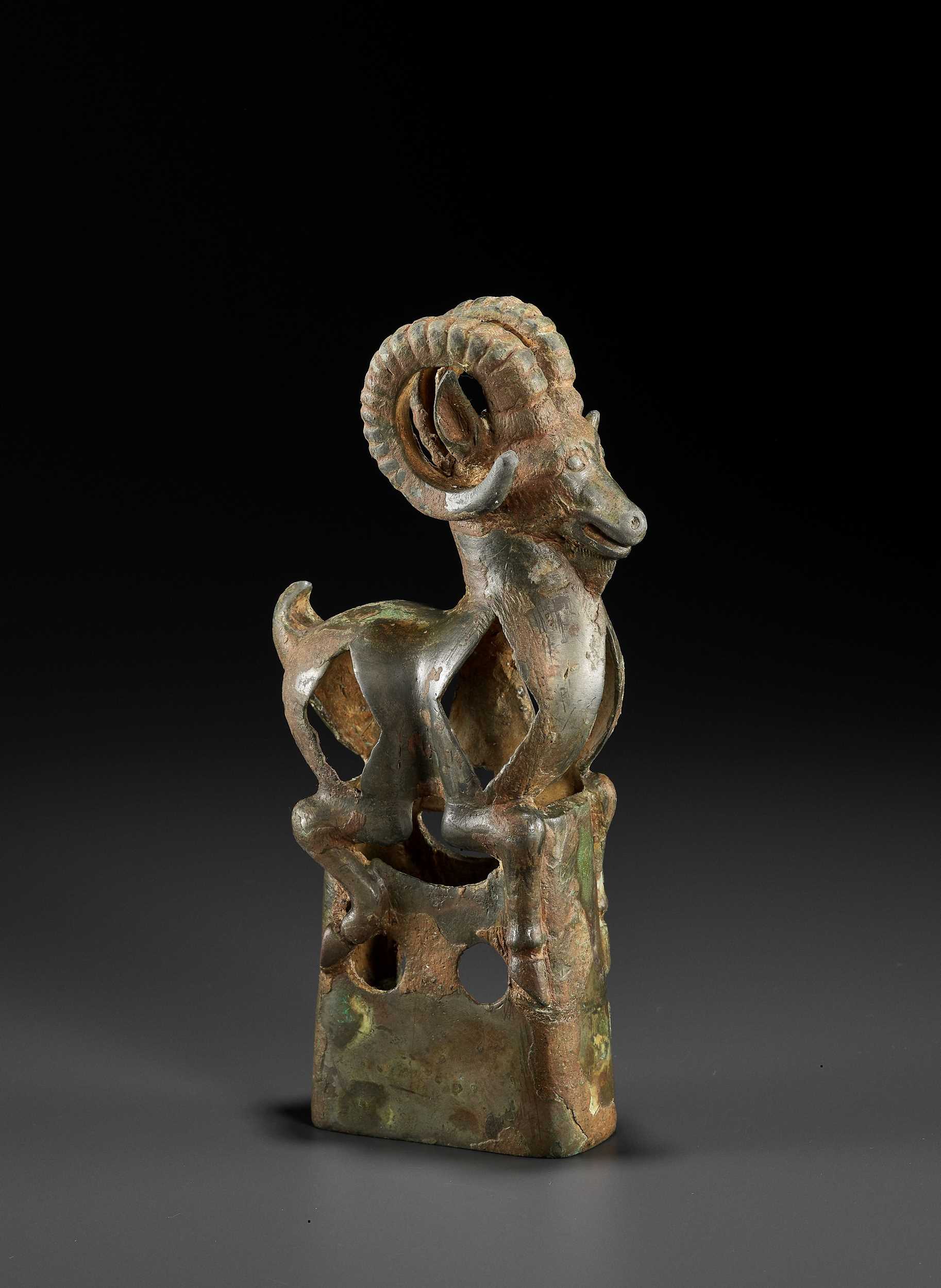30th Sep, 2022 10:00
DAY 2 - TWO-DAY AUCTION - Fine Chinese Art / 中國藝術集珍 / Buddhism & Hinduism
477
AN ‘IBEX’ BRONZE FINIAL, SOUTHERN SIBERIA, 6TH – 5TH CENTURY BC
公元前六至五世紀西伯利亞山羊銅鈕
Sold for €7,800
including Buyer's Premium
Finely cast in the form of an ibex with long, ribbed, and powerfully curved horns, as well as pricked funnel-shaped ears, and a short tail, standing atop a rectangular base. The elaborate finial probably once part of a throne or chariot, the hollow body has large diamond-shaped openings.
Provenance: From the collection of Oliver Reginald Hoare (1945-2018). Inventory label to interior of base, ‘1461 C‘. A prominent English art figure, described as arguably the most influential dealer in the Islamic world, Hoare joined Christie's London in 1967 where he was initially overseeing Russian art. After spotting some carpets left lying in a corridor and recognizing them as Persian, Hoare used them as the basis of a successful auction, which led to the launch of the Islamic Art Department, the first of its kind in a major auction house. He left Christie's in 1975 and opened Ahuan, a gallery in Pimlico, in partnership with David Sulzberger. In 1994, he negotiated the return of a Persian 16th-century manuscript to Iran, the Houghton Shahnameh (the most important illustrated manuscript ever created in Persia), in exchange for Willem de Kooning's Woman III which had been in Iran since the Islamic revolution. In the 1990s, he famously liaised with Diana, Princess of Wales.
Condition: Good condition, overall as expected and fully commensurate with age. Old wear, losses, small dents, minor nicks, extensive signs of weathering and erosion, soil encrustations. Naturally grown patina in various tones of malachite-green overall.
Weight: 751.7 g
Dimensions: Height 20.5 cm
Expert’s note: It is interesting to note that wild goats and other bovids appear in artifacts from a wide range of sites within Northern, Central and Western Asia over a long period of time spanning thousands of years. Goats are among the earliest animals domesticated by humans. The most recent genetic analysis confirms the archaeological evidence that the wild bezoar ibex of the Zagros Mountains is the likely original ancestor of probably all domestic goats today. Neolithic farmers began to herd wild goats primarily for easy access to milk and meat, as well as to their dung, which was used as fuel, and their bones, hair, and sinew which were used for clothing, building, and tools. The earliest remnants of domesticated goats dating 10,000 years before the present are found in Ganj Dareh in Iran. Goat remains have been found at archaeological sites in Jericho, Choga Mami, Djeitun, and Cayonu, dating the domestication of goats in Northern and Western Asia at between 8,000 and 9,000 years ago.
Literature comparison:
Compare a near-identical ibex bronze, 20 cm high, also attributed to Southern Siberia and dated 6th-5th century BC, at Galerie Samarcande, Paris, reference no. 88424. Compare a closely related example in the collection of the Musée Guimet, attributed to the Ordos region and dated to the second half of the first millennium BC, inventory number MA 3410.
Auction result comparison:
Type: Related
Auction: Christie’s New York, 27 October 2004, lot 175
Price: GBP 14,340 or approx. EUR 26,200 converted and adjusted for inflation at the time of writing
Description: An Achaemenid Bronze Figure of an Ibex, Second Half of 5th Century BC
Expert’s remark: Compare with an Achaemenid version of the same subject, dating from the same period, but of smaller size (9 cm).
公元前六至五世紀西伯利亞山羊銅鈕
山羊形,羊角雄健有力,漏斗形耳朵,短尾,生動活潑,矩形鈕。可能曾經是寶座或戰車的一部分,中空,菱形開口。
來源:Oliver Reginald Hoare (1945-2018) 收藏。Hoare是一位著名的英國藝術人物,可以說是伊斯蘭世界最有影響力的經銷商,他於 1967 年加入倫敦佳士得,最初負責監督俄羅斯藝術。他發現一些放在走廊上的地毯是波斯地毯後,Hoare將它們進行了成功的拍賣,以此爲基礎成立了伊斯蘭藝術部,這是大型拍賣行中的此方面第一個部門。他於 1975 年離開佳士得,與 David Sulzberger 合作在 Pimlico 開設了 Ahuan 藝廊。1994 年,他通過談判將一份十六世紀的波斯手稿《Houghton Shahnameh》(波斯有史以來最重要的插圖手稿)歸還給伊朗,以換取自伊斯蘭革命以來一直在伊朗的Willem de Kooning《女人III》。 1990 年代,他與威爾士王妃戴安娜有過交往。
品相:狀況良好,總體符合預期,與年齡完全相符。 磨損、缺損、小凹痕、輕微劃痕、大面積風化和侵蝕,土壤結殼。 自然生長的孔雀綠色包漿。
重量:751.7 克
尺寸:高20.5 厘米
專家注釋:有趣的是,在跨越數千年的漫長歲月裡,野山羊和其他牛科動物出現在來自北亞、中亞和西亞等地的文物中。山羊是人類最早馴化的動物之一。最近的基因分析證實了考古發現表明,扎格羅斯山脈的野生牛黃高地山羊可能是今天所有家山羊的原始祖先。新石器時代的農民開始放牧野山羊,主要是為了更容易獲得牛奶和肉,以及用作燃料的糞便,以及用於衣服、建築和工具的骨頭、羊毛和筋腱。在伊朗的甘傑達雷赫發現了距今 10,000 年前馴養山羊遺跡。在傑里科、喬伽瑪米、傑頓 和 卡育努的考古遺址中發現了山羊遺骸,可以追溯到 8,000 至 9,000 年的北亞和西亞地區。
文獻比較:
比較一件幾乎相同的西元前6-5世紀山羊青銅器,高20厘米,也是來自南西伯利亞,收藏於巴黎薩馬坎德畫廊,參考編號88424。88424. 比較另一件非常相近的例子,西元前一千年的後半段鄂爾多斯地區山羊青銅器,收藏於吉美博物館年代為,庫存編號為MA 3410。
拍賣結果比較:
形制:相近
拍賣:紐約佳士得,2004年10月27日,lot 175
價格:GBP 14,340(相當於今日EUR 26,200)
描述:公元前5世纪下半葉阿契美尼德時期山羊青銅像
專家評論:比較相同主題的阿契美尼德版本,同一時期,但尺寸較小(9 厘米)。
Finely cast in the form of an ibex with long, ribbed, and powerfully curved horns, as well as pricked funnel-shaped ears, and a short tail, standing atop a rectangular base. The elaborate finial probably once part of a throne or chariot, the hollow body has large diamond-shaped openings.
Provenance: From the collection of Oliver Reginald Hoare (1945-2018). Inventory label to interior of base, ‘1461 C‘. A prominent English art figure, described as arguably the most influential dealer in the Islamic world, Hoare joined Christie's London in 1967 where he was initially overseeing Russian art. After spotting some carpets left lying in a corridor and recognizing them as Persian, Hoare used them as the basis of a successful auction, which led to the launch of the Islamic Art Department, the first of its kind in a major auction house. He left Christie's in 1975 and opened Ahuan, a gallery in Pimlico, in partnership with David Sulzberger. In 1994, he negotiated the return of a Persian 16th-century manuscript to Iran, the Houghton Shahnameh (the most important illustrated manuscript ever created in Persia), in exchange for Willem de Kooning's Woman III which had been in Iran since the Islamic revolution. In the 1990s, he famously liaised with Diana, Princess of Wales.
Condition: Good condition, overall as expected and fully commensurate with age. Old wear, losses, small dents, minor nicks, extensive signs of weathering and erosion, soil encrustations. Naturally grown patina in various tones of malachite-green overall.
Weight: 751.7 g
Dimensions: Height 20.5 cm
Expert’s note: It is interesting to note that wild goats and other bovids appear in artifacts from a wide range of sites within Northern, Central and Western Asia over a long period of time spanning thousands of years. Goats are among the earliest animals domesticated by humans. The most recent genetic analysis confirms the archaeological evidence that the wild bezoar ibex of the Zagros Mountains is the likely original ancestor of probably all domestic goats today. Neolithic farmers began to herd wild goats primarily for easy access to milk and meat, as well as to their dung, which was used as fuel, and their bones, hair, and sinew which were used for clothing, building, and tools. The earliest remnants of domesticated goats dating 10,000 years before the present are found in Ganj Dareh in Iran. Goat remains have been found at archaeological sites in Jericho, Choga Mami, Djeitun, and Cayonu, dating the domestication of goats in Northern and Western Asia at between 8,000 and 9,000 years ago.
Literature comparison:
Compare a near-identical ibex bronze, 20 cm high, also attributed to Southern Siberia and dated 6th-5th century BC, at Galerie Samarcande, Paris, reference no. 88424. Compare a closely related example in the collection of the Musée Guimet, attributed to the Ordos region and dated to the second half of the first millennium BC, inventory number MA 3410.
Auction result comparison:
Type: Related
Auction: Christie’s New York, 27 October 2004, lot 175
Price: GBP 14,340 or approx. EUR 26,200 converted and adjusted for inflation at the time of writing
Description: An Achaemenid Bronze Figure of an Ibex, Second Half of 5th Century BC
Expert’s remark: Compare with an Achaemenid version of the same subject, dating from the same period, but of smaller size (9 cm).
公元前六至五世紀西伯利亞山羊銅鈕
山羊形,羊角雄健有力,漏斗形耳朵,短尾,生動活潑,矩形鈕。可能曾經是寶座或戰車的一部分,中空,菱形開口。
來源:Oliver Reginald Hoare (1945-2018) 收藏。Hoare是一位著名的英國藝術人物,可以說是伊斯蘭世界最有影響力的經銷商,他於 1967 年加入倫敦佳士得,最初負責監督俄羅斯藝術。他發現一些放在走廊上的地毯是波斯地毯後,Hoare將它們進行了成功的拍賣,以此爲基礎成立了伊斯蘭藝術部,這是大型拍賣行中的此方面第一個部門。他於 1975 年離開佳士得,與 David Sulzberger 合作在 Pimlico 開設了 Ahuan 藝廊。1994 年,他通過談判將一份十六世紀的波斯手稿《Houghton Shahnameh》(波斯有史以來最重要的插圖手稿)歸還給伊朗,以換取自伊斯蘭革命以來一直在伊朗的Willem de Kooning《女人III》。 1990 年代,他與威爾士王妃戴安娜有過交往。
品相:狀況良好,總體符合預期,與年齡完全相符。 磨損、缺損、小凹痕、輕微劃痕、大面積風化和侵蝕,土壤結殼。 自然生長的孔雀綠色包漿。
重量:751.7 克
尺寸:高20.5 厘米
專家注釋:有趣的是,在跨越數千年的漫長歲月裡,野山羊和其他牛科動物出現在來自北亞、中亞和西亞等地的文物中。山羊是人類最早馴化的動物之一。最近的基因分析證實了考古發現表明,扎格羅斯山脈的野生牛黃高地山羊可能是今天所有家山羊的原始祖先。新石器時代的農民開始放牧野山羊,主要是為了更容易獲得牛奶和肉,以及用作燃料的糞便,以及用於衣服、建築和工具的骨頭、羊毛和筋腱。在伊朗的甘傑達雷赫發現了距今 10,000 年前馴養山羊遺跡。在傑里科、喬伽瑪米、傑頓 和 卡育努的考古遺址中發現了山羊遺骸,可以追溯到 8,000 至 9,000 年的北亞和西亞地區。
文獻比較:
比較一件幾乎相同的西元前6-5世紀山羊青銅器,高20厘米,也是來自南西伯利亞,收藏於巴黎薩馬坎德畫廊,參考編號88424。88424. 比較另一件非常相近的例子,西元前一千年的後半段鄂爾多斯地區山羊青銅器,收藏於吉美博物館年代為,庫存編號為MA 3410。
拍賣結果比較:
形制:相近
拍賣:紐約佳士得,2004年10月27日,lot 175
價格:GBP 14,340(相當於今日EUR 26,200)
描述:公元前5世纪下半葉阿契美尼德時期山羊青銅像
專家評論:比較相同主題的阿契美尼德版本,同一時期,但尺寸較小(9 厘米)。
Zacke Live Online Bidding
Our online bidding platform makes it easier than ever to bid in our auctions! When you bid through our website, you can take advantage of our premium buyer's terms without incurring any additional online bidding surcharges.
To bid live online, you'll need to create an online account. Once your account is created and your identity is verified, you can register to bid in an auction up to 12 hours before the auction begins.
Intended Spend and Bid Limits
When you register to bid in an online auction, you will need to share your intended maximum spending budget for the auction. We will then review your intended spend and set a bid limit for you. Once you have pre-registered for a live online auction, you can see your intended spend and bid limit by going to 'Account Settings' and clicking on 'Live Bidding Registrations'.
Your bid limit will be the maximum amount you can bid during the auction. Your bid limit is for the hammer price and is not affected by the buyer’s premium and VAT. For example, if you have a bid limit of €1,000 and place two winning bids for €300 and €200, then you will only be able to bid €500 for the rest of the auction. If you try to place a bid that is higher than €500, you will not be able to do so.
Online Absentee and Telephone Bids
You can now leave absentee and telephone bids on our website!
Absentee Bidding
Once you've created an account and your identity is verified, you can leave your absentee bid directly on the lot page. We will contact you when your bids have been confirmed.
Telephone Bidding
Once you've created an account and your identity is verified, you can leave telephone bids online. We will contact you when your bids have been confirmed.
Classic Absentee and Telephone Bidding Form
You can still submit absentee and telephone bids by email or fax if you prefer. Simply fill out the Absentee Bidding/Telephone bidding form and return it to us by email at office@zacke.at or by fax at +43 (1) 532 04 52 20. You can download the PDF from our Upcoming Auctions page.
How-To Guides
How to Create Your Personal Zacke Account
How to Register to Bid on Zacke Live
How to Leave Absentee Bids Online
How to Leave Telephone Bids Online
中文版本的操作指南
创建新账号
注册Zacke Live在线直播竞拍(免平台费)
缺席投标和电话投标
Third-Party Bidding
We partner with best-in-class third-party partners to make it easy for you to bid online in the channel of your choice. Please note that if you bid with one of our third-party online partners, then there will be a live bidding surcharge on top of your final purchase price. You can find all of our fees here. Here's a full list of our third-party partners:
- 51 Bid Live
- EpaiLive
- ArtFoxLive
- Invaluable
- LiveAuctioneers
- the-saleroom
- lot-tissimo
- Drouot
Please note that we place different auctions on different platforms. For example, in general, we only place Chinese art auctions on 51 Bid Live.
Bidding in Person
You must register to bid in person and will be assigned a paddle at the auction. Please contact us at office@zacke.at or +43 (1) 532 04 52 for the latest local health and safety guidelines.
